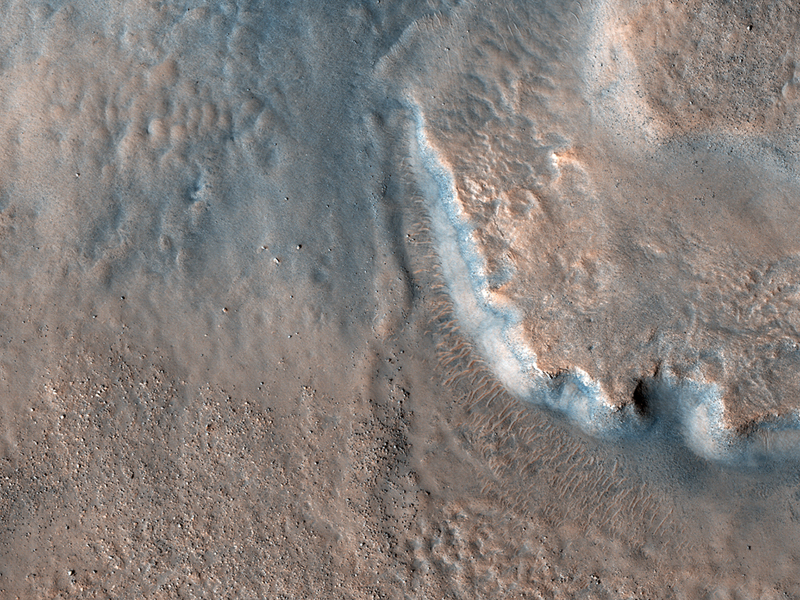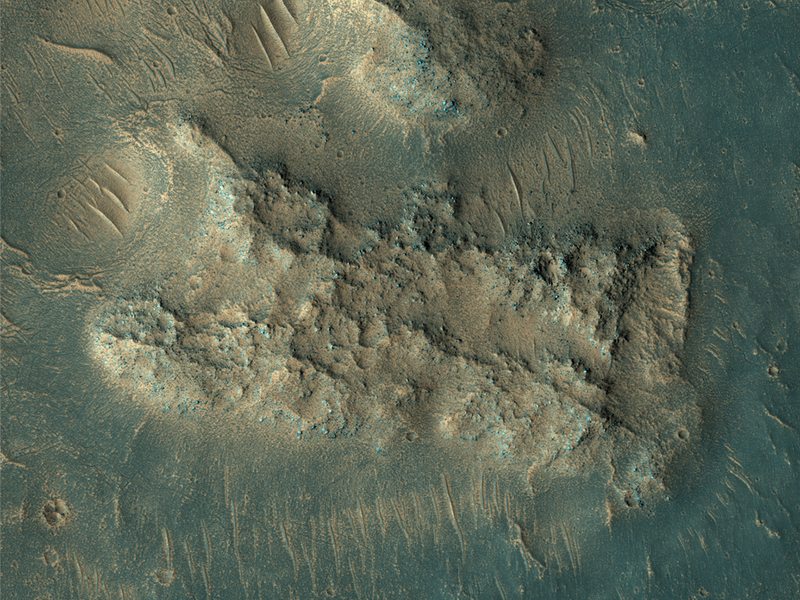HiRISE Updates Week of 2018 Jul 23
Posted: Fri Jul 27, 2018 5:00 pm
Sharon Wilson Purdy wrote:Fans of Roddy Crater (ESP_033471_1580) (HiClip)
Alluvial fans are found on Earth, Mars, and even Saturn’s moon, Titan. Roddy Crater on Mars is home to several large alluvial fans, which formed as water moved sediment from the mountainous crater rim and deposited it onto the flatter crater floor.
The fans built up over time during intense rain storms or from melting snow. Due to the strong winds on Mars, the river channels that once carried water and sediment on the fan surfaces are now standing as raised ridges and platforms. A thin blanket of ejecta (upper right) from a small crater on Roddy’s eastern rim protected underlying fan surfaces from modification by the wind compared to nearby, unprotected fans (left). The scarp beneath the thin ejecta surface exposes beautiful light-toned layers from the alluvial fans below.
This is a stereo pair with ESP_028579_1580.
Jennifer Newman, Eric Pilles, Sarah Simpson, Alyssa Werynski, Livio Tornabene wrote:The Dark Side of Dust Avalanches (ESP_055285_2030) (HiClip)
Changes on the Martian surface are detected by imaging the same area more than once. Here, we see several new dust avalanches on the slopes of ridges within the Olympus Mons Aureole. These changes occurred within six years. (Also see the animated GIF).
Dust avalanches create slope streaks that expose darker materials usually hidden below a lighter-toned layer. Cascading fine-grained material easily diverts around boulders or alters direction when encountering a change in slope (see the top right corner of the first close-up). The dark steak in another close-up is approximately 1 kilometer in length that we didn’t see in a previous image. Past avalanche sites are still visible and fading slowly as dust settles out of the atmosphere and is deposited on the dark streaks over time.
We also see boulders and their shadows that are a meter or greater in size. Movement of any of these boulders down the slope could trigger future avalanches.
Sharon Wilson Purdy wrote:Fans and Valleys (ESP_055110_2265) (HiClip)
An impact crater approximately 23 kilometers across is home to fan-shaped deposits that extend from the rim and sit on the interior crater floor.
Thick beds with varying tone are exposed along the edge of the fan. Shallow valleys that carve into the smooth upland surfaces outside of the crater may provide clues regarding the formation of the deposits. Many boulder-sized blocks sit on the interior crater floor beyond the toe (distal edge) of the deposits.
This fan-hosting crater is located near the boundary between Tempe Terra and Acidalia Planitia in the Northern Hemisphere of Mars.
Sarah Simpson, Alyssa Werynski, Jennifer Newman, Eric Pilles, Livio Tornabene wrote:This is Not the Hydrothermal Deposit You’re Looking For (ESP_055282_2125) (HiClip)
A hotspot for exploration on Mars centers on areas that were once, or are currently, next to a significant source of heat such as volcanoes. Martian volcanoes have not been active for the last couple million years, but beneath the shifting sands and dust of the Red Planet we find old lava flows frozen in time.
These ancient lava flows may have provided a source of heat, along with liquid water or subsurface ice, to generate an environment conducive for the development of ancient life. Geological evidence for hot water interacting with rock is what we mean by hydrothermal: sites with these conditions are very difficult to identify from orbit.
One closeup view shows sand dunes scouring what appears to be a highly-cratered, old lava flow in the Tempe Terra region, located in the Northern Hemisphere. The flat, dark areas are basaltic in composition, a rock commonly found around active volcanoes, and the lighter-toned material is covered in rusted Martian dust. The recently-launched InSight lander will reveal whether Mars is geologically active internally.
Credit: NASA/JPL-Caltech/University of Arizona
<< Previous HiRISE Update



